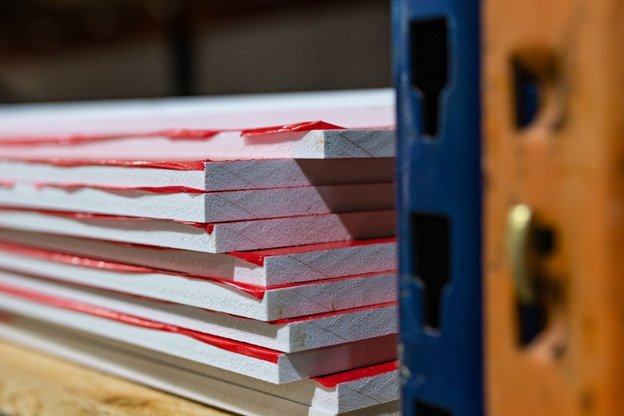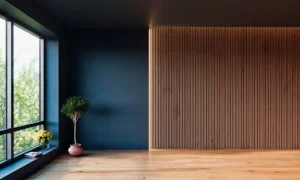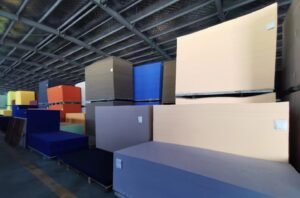The effect of soundproofing materials
So, does it mean that in order to obtain the best sound insulation effect, we have to increase the thickness of the steel plate infinitely? In fact, in terms of engineering, first, it will be relatively heavy, and second, the cost is too high. Therefore, acoustic scientists have thought of many ways to combine different lightweight materials in different ways to obtain better sound insulation effects. For example, if a 5CM thick sound-absorbing cotton is placed in the cavity between two layers of wood, the sound insulation effect obtained is equivalent to that of a 3MM thick steel plate.
Characteristics of sound insulation materials
Sound insulation materials are not as porous, loose, and breathable as sound-absorbing materials to weaken the transmitted sound energy and block the transmission of sound. On the contrary, their materials should be heavy and dense, such as steel plates, lead plates, brick walls and other materials. The material requirement of the sound insulation material is dense without pores or gaps; it has a relatively large weight. Because this kind of sound insulation material is dense, it is difficult to absorb and transmit sound energy and has strong reflection energy, so its sound absorption performance is poor.
The development process of sound-absorbing materials
The meaning of sound-absorbing materials
Most of the sound-absorbing materials are loose and porous materials, such as slag wool, blankets, etc. The sound-absorbing mechanism is that the sound waves penetrate into the pores of the material, and the pores are mostly open holes that communicate with each other inside, which are subjected to friction and viscous resistance of air molecules. Fibers vibrate mechanically, thereby converting sound energy into heat energy. The sound absorption coefficient of this kind of porous sound-absorbing material generally increases gradually from low frequency to high frequency, so the sound absorption effect on high frequency and intermediate frequency is better. When the sound wave reaches the surface of the sound-absorbing material, the sound energy generates frictional vibration in the air in the gap of the sound-absorbing material, and the sound energy is converted into heat energy and consumed.
The use of sound-absorbing materials
In engineering, the goals and focuses of sound-absorbing materials and sound-insulating materials are different. The goal of attracting treatment is to reduce the repeated reflection of sound in the room, that is, to reduce the reverberation sound in the room and shorten the duration of the reverberation sound, that is, the reverberation time. ; In the case of continuous noise, this weakening is manifested as a reduction in the indoor noise level, which is for the sound source and sound-absorbing materials in the same building space. The sound-absorbing material also acts as an attraction for the sound coming from the adjacent room, which is equivalent to improving the sound insulation of the enclosure structure.
The effect of sound-absorbing materials
Characteristics of sound-absorbing materials
The sound insulation material is to isolate the noise from the sound source room to the adjacent room, so that the adjacent room is free from noise interference. It can be seen that the effect of using sound-insulating materials or sound-insulating structures to isolate noise is much higher than that of using sound-absorbing materials. However, the unique function of sound-absorbing materials is more manifested in the ability to shorten and adjust the reverberation time in the room, and no other material can replace it. There is an essential difference between sound absorption and sound insulation, but in specific noise reduction engineering applications, they are often combined to exert an extraordinary noise reduction effect.
The difference between sound-absorbing materials and sound-insulating materials
Material difference
The material of the sound-absorbing material is a porous, granular or foaming material, so the sound-absorbing material we buy will have many apertures inside and is soft, such as groove wood sound-absorbing panels, polyester fiber sound-absorbing panels, etc. Material.
The material of the sound insulation material is a material with heavy weight and high density. Theoretically, the higher the density of the sound insulation material, the better the sound insulation effect. For example, glass magnesium damping sound insulation board, damping sound insulation felt, etc. are all sound insulation materials.
Process difference
Sound-absorbing materials are usually produced with polyester, granular or foamed materials to form porous sound-absorbing materials.
The sound insulation material should be dense and thick, and the entire material should have no gaps on the surface or inside, and it is heavy.
Material structure difference
There will be a lot of interpenetrating micropores in the sound-absorbing material, and the micropores connected in series from the inside to the outside and from the outside to the inside. Use your hands to feel it on the other side. If the density is high, it will not blow through.
The structure of sound-insulating materials and sound-absorbing materials is just the opposite. There are no gaps and apertures, but they are dense. Since the materials of sound-insulating materials are dense and heavy, sound-insulating materials cannot absorb sound energy.
Material principle difference
The sound-absorbing material has many micropores through it, so when the sound enters these micropores, the air in the micropores is caused to vibrate, and the sound will rub against the walls of the micropores, coupled with the resistance of the air in the micropores and heat conduction. , can convert the sound entering the sound-absorbing material into heat energy, and play a very good sound-absorbing effect.
The working principle of sound-insulating materials is just the opposite of that of sound-absorbing materials. Sound-insulating materials do not need to absorb and convert sound, but directly isolate noise. Because sound-insulating materials themselves have a high density, sound cannot pass through, so it only insulates and does not absorb sound. , but if the sound insulation material is used alone, the reverberation in the room will be very large, so the sound insulation material and the sound absorption material are used together in the room.
Material use difference
Sound-absorbing materials can be used when the source of the sound cannot be isolated, but the noise needs to be reduced, such as the sound of talking in the room, or the sound of playing the piano.
Sound insulation materials can be used when the source of the noise can be isolated and the noise does not want to affect the next door, such as the partition wall between the private rooms of KTV and the content of the conference room. Soundproofing materials can be used at these times to prevent outsiders from hearing.




